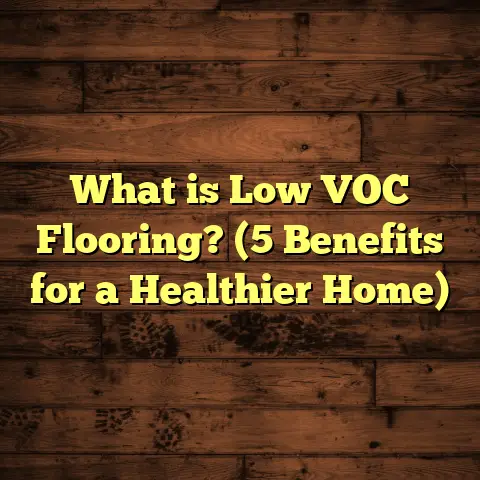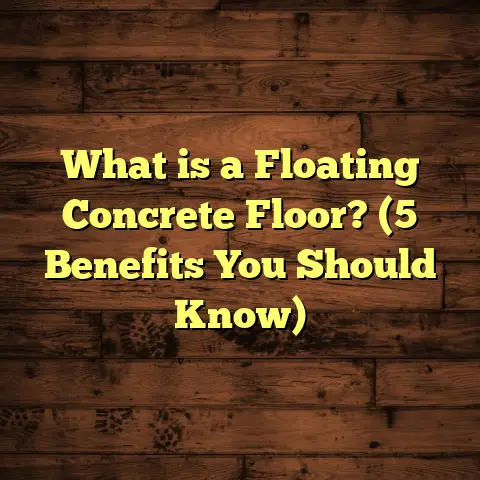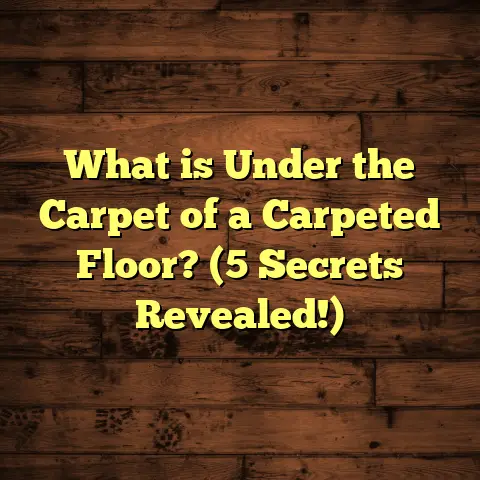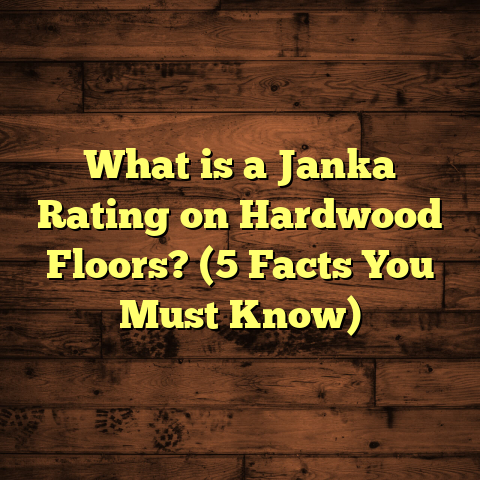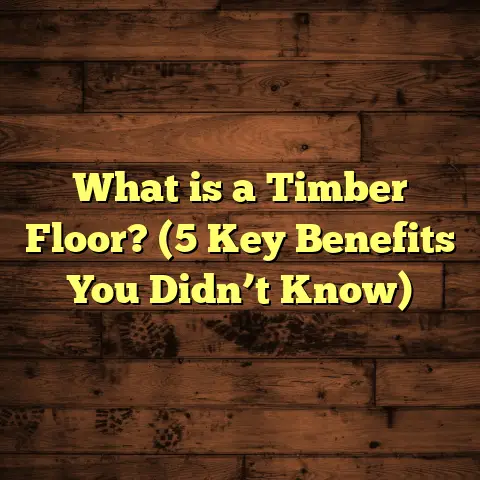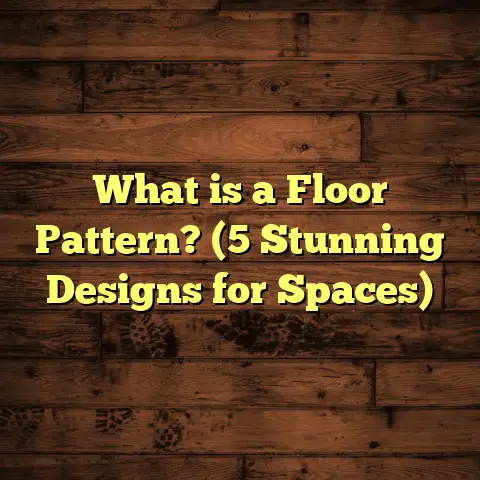What is Vinyl Flooring (5 Essential Tips for a Perfect Install)
I remember standing in front of the flooring aisle at my local hardware store, utterly confused by endless vinyl options. “Which one should I pick? How do I even install this properly?” If you’ve ever felt overwhelmed by vinyl flooring choices or worried about making a costly mistake, you’re not alone. I’ve been there too. Over the years, installing vinyl floors in my own homes and for clients, I’ve learned what works and what doesn’t.
By the time you finish reading this, you’ll know exactly what vinyl flooring is, why it’s such a popular choice, and how to install it flawlessly. I’ll share personal experiences, technical details, and real data so you get a full picture—not just surface-level info.
What Is Vinyl Flooring?
Vinyl flooring is a synthetic flooring material made from polyvinyl chloride (PVC), combined with other compounds to create a flexible, durable surface. It’s designed to imitate natural materials like hardwood or stone but offers affordability and toughness that many natural floors can’t match.
The Composition — Layers Explained
Vinyl flooring isn’t just one solid piece; it’s a multi-layered product engineered for performance:
- Wear Layer: The top transparent layer shields the floor from scratches, stains, and daily wear. This layer’s thickness usually ranges from 6 to 20 mils (1 mil = 0.001 inch). Residential floors generally have 6-12 mil wear layers, while commercial floors use 20 mil or more.
- Design Layer: Just underneath the wear layer is a printed image of wood grain, stone texture, tile pattern, or other designs. This layer determines the floor’s look.
- Core/Backing Layer: Provides structure and support. This can vary widely in composition—rigid cores made with wood plastic composites (WPC), stone plastic composites (SPC), or flexible vinyl sheets.
Manufacturing Process
The manufacturing of vinyl flooring is a precise chemical and mechanical process:
- Compound Preparation: PVC resin is mixed with plasticizers (to make it flexible), stabilizers (to resist heat and UV), pigments, and fillers.
- Calendering or Extrusion: The vinyl mixture is rolled into thin sheets or extruded into planks.
- Layer Assembly: Multiple layers are laminated together under heat and pressure. For LVPs and LVTs (luxury vinyl tile), the printed design layer is added between the wear layer and backing.
- Curing: The finished product is cured to lock in durability and flexibility.
- Cutting & Finishing: Sheets are cut to size or planks are shaped, edges are beveled (for planks), and quality checks ensure consistency.
Types of Vinyl Flooring
- Sheet Vinyl: Comes in large rolls (typically 6-12 feet wide). It offers a seamless look when installed properly, making it excellent for bathrooms or kitchens where moisture is an issue.
- Luxury Vinyl Tile (LVT): Square tiles designed to look like ceramic or stone tiles but with more comfort underfoot and easier installation.
- Luxury Vinyl Plank (LVP): Planks that mimic hardwood flooring in size and appearance. They can have rigid cores for better stability.
Why Vinyl Flooring? The Benefits That Got Me Hooked
When I first started working with vinyl floors, I was drawn by their blend of style, durability, and cost. Here’s what makes them stand out:
Affordability Without Sacrificing Style
Vinyl flooring costs range widely depending on type and quality:
- Basic sheet vinyl can be as low as $1.50 per square foot.
- Mid-range luxury vinyl planks (with rigid cores) usually cost $3-$5 per square foot.
- High-end commercial vinyl with thick wear layers can go up to $7+ per square foot.
Compare this to hardwood ($8-$15 per sq.ft) or natural stone ($10-$20+ per sq.ft), and vinyl often wins for budget-conscious projects.
Yet, despite the affordability, you can find vinyl floors that look incredibly realistic—some manufacturers use high-resolution printing technology that mimics real wood grain or stone veins perfectly.
Durability That Surprised Me
I was skeptical about vinyl’s toughness until I saw how it performed in real life.
According to the Resilient Floor Covering Institute (RFCI):
- Vinyl floors with 12 mil wear layers can last over 10 years in residential settings.
- Commercial-grade vinyl with wear layers above 20 mils can handle heavy foot traffic for well over 15 years.
Modern innovations like ceramic bead-infused wear layers increase scratch resistance by about 30% compared to traditional designs. This makes vinyl a great choice if you have pets or kids running around.
Water Resistance
One major selling point for me was vinyl’s resistance to moisture. Unlike hardwood, which swells or warps when wet, vinyl handles spills and humidity well.
Sheet vinyl is virtually waterproof due to its continuous surface without seams. Luxury vinyl planks also resist water but need careful installation to avoid gaps where water could seep underneath.
Comfort & Noise
Vinyl has some natural cushioning compared to tile or hardwood. It’s softer underfoot, which reduces fatigue if you spend a lot of time standing in your kitchen or laundry room.
Some luxury vinyl products add an attached underlayment layer that absorbs sound and adds extra comfort—something I appreciate in busy family homes.
The Technical Side: What Makes Vinyl Flooring Tick?
If you like understanding materials on a deeper level like I do, here are some key technical specs that matter when choosing vinyl:
| Feature | Typical Range | Why It Matters |
|---|---|---|
| Wear Layer Thickness | 6–20 mils (0.15–0.5 mm) | Thicker = more durable |
| Total Thickness | 2–8 mm | Thicker floors feel sturdier |
| Abrasion Rating (ASTM D4060) | Class III-IV (Residential/Commercial) | Higher class means better scratch resistance |
| Static Load Resistance | >1000 psi | Indicates resistance to dents |
| Fire Rating | Class B or C | Safety standard |
| Formaldehyde Emission | Very low/none | Important for indoor air quality |
Core Types: WPC vs SPC
Rigid core luxury vinyl planks come mainly in two varieties:
- WPC (Wood Plastic Composite): Softer core with some give underfoot; warmer feel but less dense.
- SPC (Stone Plastic Composite): Denser core made with limestone powder; very rigid and highly durable.
I preferred SPC for high-traffic areas because it resisted dents better but chose WPC for bedrooms where comfort mattered more.
My Personal Stories Installing Vinyl Flooring
I want to share some real-life scenarios from my years installing these floors:
Story 1: Bathroom Sheet Vinyl Disaster Turned Win
In an early job, a renter asked me to install sheet vinyl in a bathroom quickly. I thought I could cut corners on subfloor prep since it was just rental property.
Big mistake.
After two weeks, the floor bubbled in spots because of moisture trapped under the sheet. This forced me to pull it up and do a thorough moisture test plus leveling compound application before reinstalling.
This experience hammered home how critical subfloor prep is—especially for sheet vinyl.
Story 2: Kitchen Vinyl Plank Success
For my own kitchen remodel, I went with luxury vinyl planks with an SPC core and a 12 mil wear layer featuring ceramic bead technology.
Installation took three days with my small team. We acclimated the planks for 48 hours prior, leveled the subfloor carefully, and left proper expansion gaps.
Six months later, two kids and a dog have tested it hard—no scratches, no swelling from spills, easy cleanup after meals. This confirmed my confidence in premium LVP products when installed right.
Step-by-Step Guide: Installing Vinyl Flooring Like a Pro
Here’s my detailed walkthrough based on years of experience:
Step 1: Measure Your Space Accurately
Get exact square footage by measuring length x width of each room area separately if needed.
Add at least 10% extra for waste—especially if you’re cutting planks around obstacles.
Step 2: Inspect and Prepare Your Subfloor
Check subfloor moisture using a reliable meter—concrete should be below 3 lbs per 1000 sq.ft per 24 hours (calcium chloride test).
Fill cracks with leveling compound; sand down bumps.
Clean dust thoroughly—we want perfect adhesion.
Step 3: Acclimate Your Vinyl Flooring
Store unopened boxes in the room for at least 48 hours so the material adjusts to temperature/humidity.
Avoid installing right out of an unheated garage or cold basement during winter.
Step 4: Lay Out a Dry Run
Before gluing or clicking anything down permanently:
- Lay out planks or sheets without adhesive.
- Plan your starting point—usually along the longest wall.
- Check for patterns and color variations to distribute evenly.
This step saved me grief by catching awkward cuts or mismatched patterns early.
Step 5: Install According to Product Type
For Sheet Vinyl:
- Roll out adhesive evenly using recommended trowel.
- Press sheet firmly; use a roller tool to remove bubbles.
- Trim edges carefully around door jambs and walls.
For Luxury Vinyl Planks/Tiles:
- Use spacers at walls for expansion gaps.
- Click planks firmly together using tapping blocks.
- Stagger joints in successive rows for natural look and stability.
Step 6: Finish Edges & Transitions
Use appropriate moldings or transition strips where flooring meets other materials like carpet or tile.
Check that expansion gaps aren’t covered by moldings—they need to remain free to allow floor movement.
Troubleshooting Common Issues From My Experience
Even with care, things can go wrong:
Problem: Peeling or Lifting Edges
Often caused by poor adhesive application or dirty subfloor.
Solution: Remove loose tiles/planks; clean area; reapply adhesive properly.
Problem: Gaps Between Planks
Usually due to insufficient acclimation or improper spacing during install.
Solution: Remove affected planks; re-acclimate; reinstall with correct expansion gaps.
Problem: Surface Scratches
If wear layer is thin or abrasive cleaners were used.
Solution: Use protective pads on furniture; avoid harsh chemicals; consider refinishing products designed for vinyl floors.
Maintenance Tips That Keep Floors Looking New
Here’s what I do regularly:
- Sweep/vacuum daily to prevent dirt buildup.
- Mop weekly with pH-neutral cleaner specifically made for vinyl floors.
- Immediately wipe spills—don’t let liquids sit.
- Place mats at entrances to reduce tracked-in grit.
- Use furniture pads under legs.
Following these simple steps has kept my floors looking fresh even after years of use.
Real Data & Industry Insights
According to a survey by Professional Remodeler magazine:
- Vinyl flooring installations increased by 15% over five years due to rising demand for affordable durable flooring.
- Over 60% of homeowners prefer luxury vinyl plank over laminate for water resistance and realism.
A recent study from Home Innovation Research Labs found:
- Homes with vinyl flooring had a 25% lower replacement rate compared to laminate floors after five years.
These data points reflect why I trust vinyl as a reliable choice for most residential applications.
Frequently Asked Questions I Encounter
Q: How long does vinyl flooring last?
A: Typically about 10–20 years depending on wear layer thickness and maintenance.
Q: Can I install vinyl flooring myself?
A: Yes! Many luxury vinyl products are designed for DIY with click-lock systems. Sheet vinyl usually requires professional installation due to adhesives involved.
Q: Is vinyl flooring environmentally friendly?
A: Vinyl is made from PVC which isn’t biodegradable but some manufacturers now offer recycling programs and low-VOC products improving indoor air quality.
Wrapping Up My Take on Vinyl Flooring
Choosing vinyl flooring was one of the best decisions I’ve made for both my home projects and client jobs. It offers unbeatable value—affordable pricing combined with durability, easy maintenance, and beautiful aesthetics.
If you follow the tips above—especially preparing the subfloor carefully, acclimating your material, using correct installation techniques, and maintaining your floor—you’ll get results that last many happy years.
Feel free to reach out if you want help with your specific project—I love talking shop about all things flooring!
